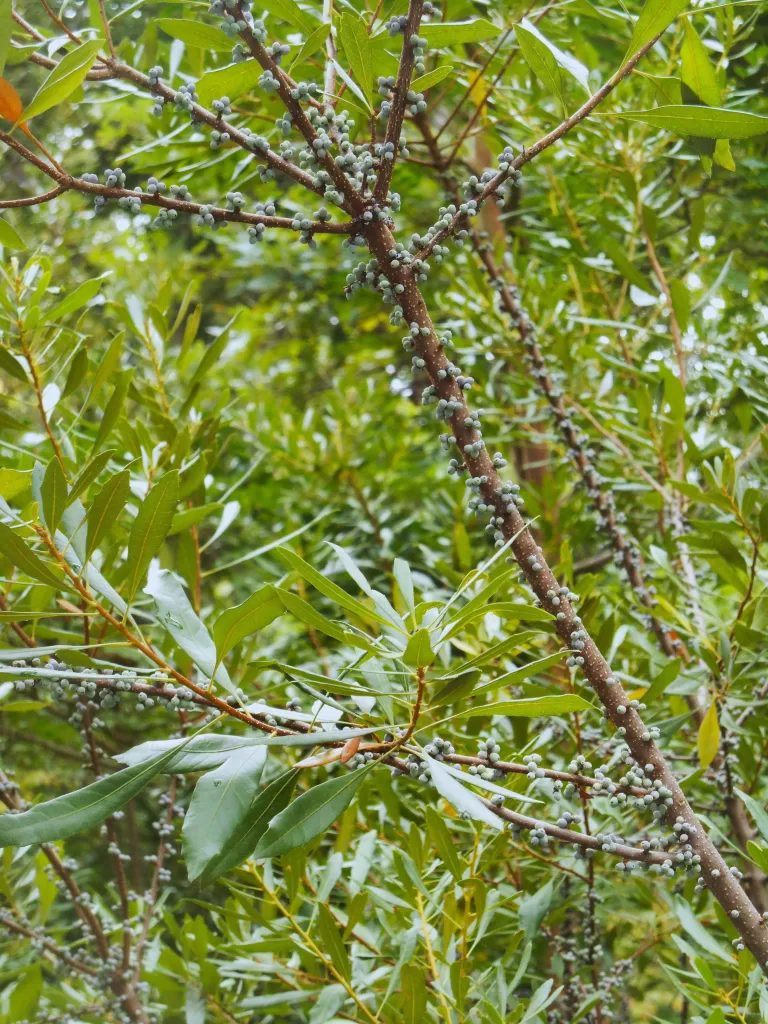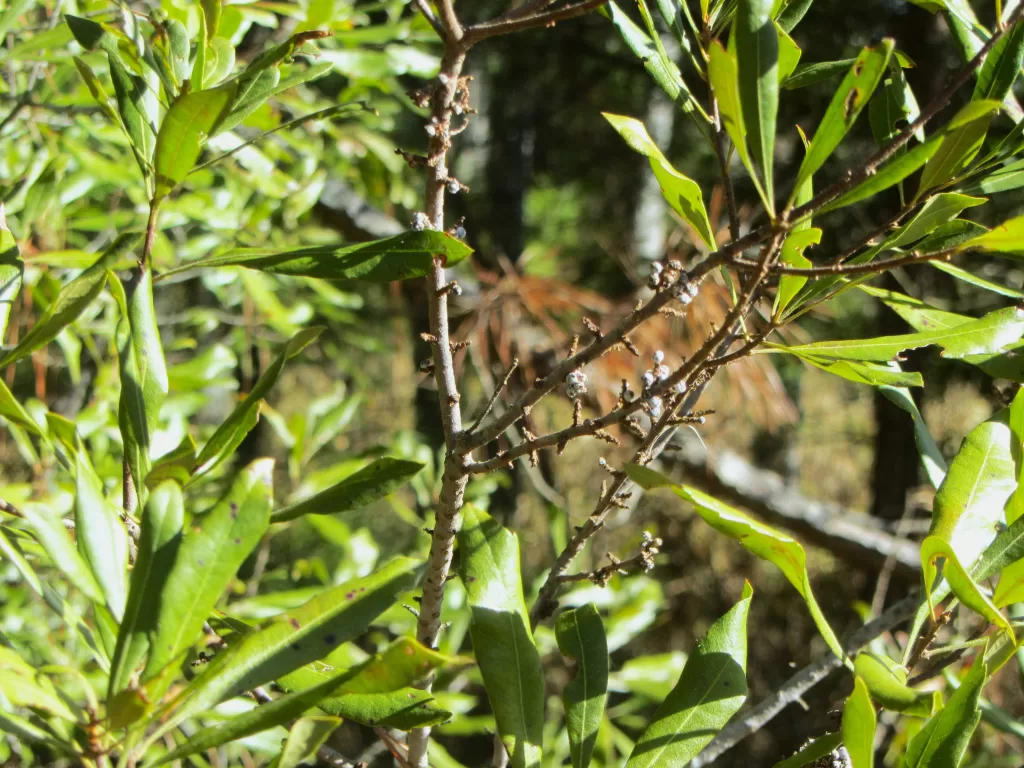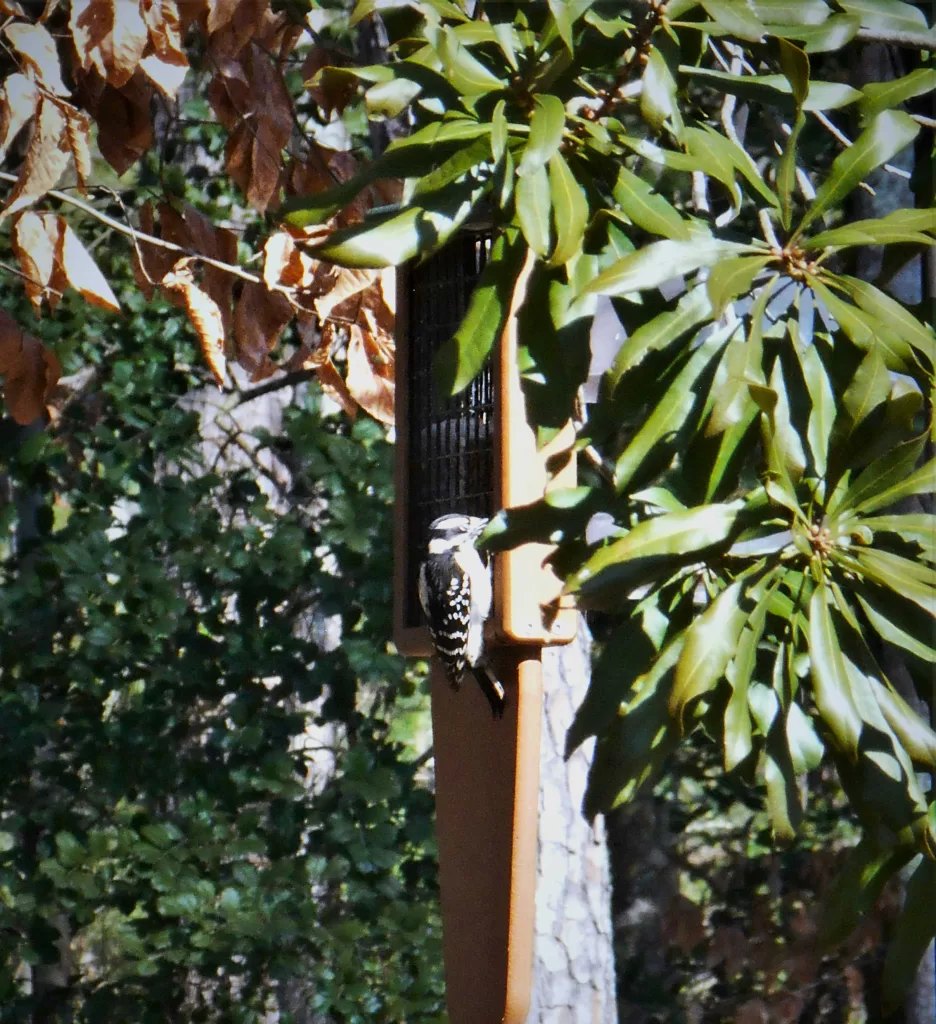Myrica Is Mostly for the Birds
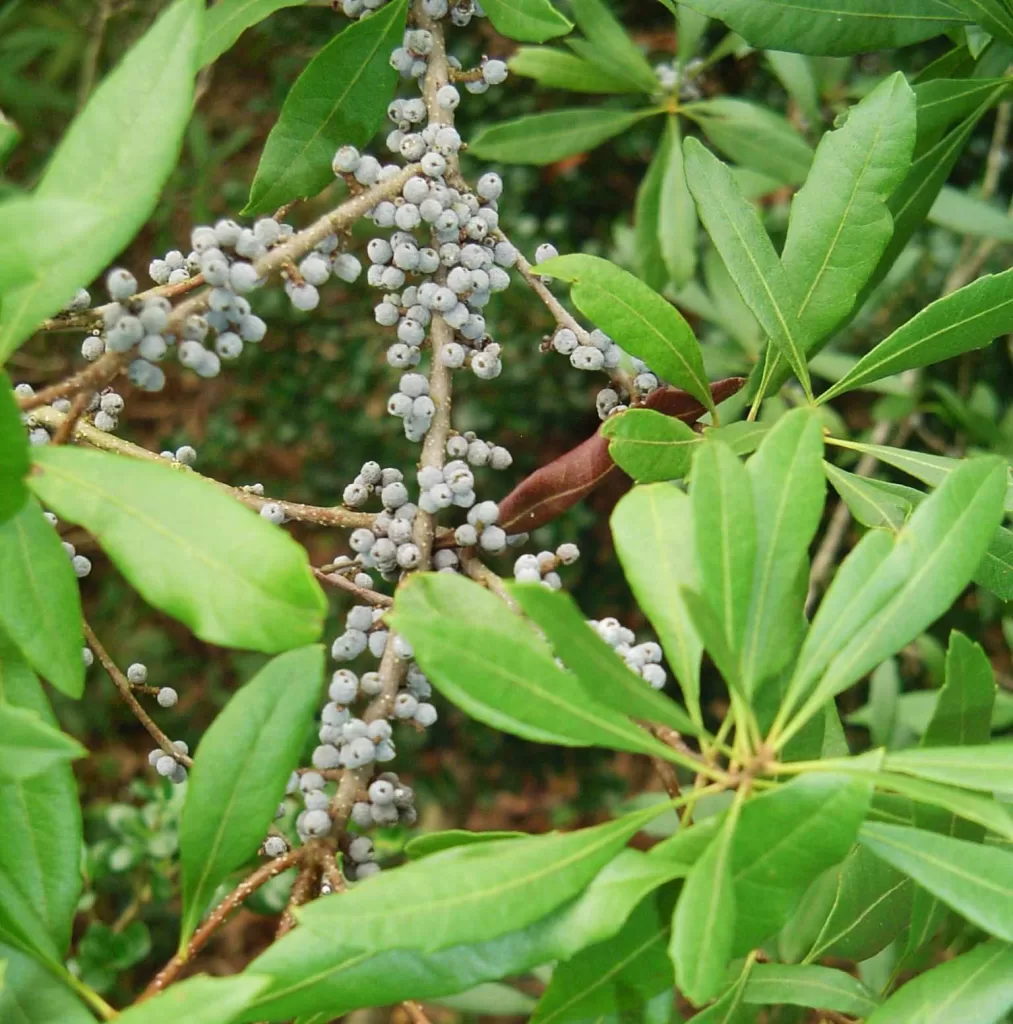
Fruits ripen on Myrica cerifera, October 2013
A Mystery and A Memory
We found several large evergreen shrubs in our new yard that we couldn’t immediately identify, when we moved here over a decade ago. We could pick out the boxwood and Camellias, but we were especially curious about the very tall, open shrubs that the birds loved the most. It was August, and tiny bluish gray drupes were ripening along this shrub’s woody stems. Its leaves were fragrant. Birds gathered in its dense and twiggy branches, chattering, and feasting on the fruit. Something about the fragrance of this shrub’s leaves and fruit recalled childhood memories. Solving that mystery opened the door to my learning about all of the various trees and shrubs in our new garden.
I eventually remembered the fragrance of bayberry, my mother’s favorite scented candles, usually purchased just up the road at the old Williamsburg Pottery’s Candle Factory. We visited at least once a year, when I was growing up, often pausing to watch the manufacture of candles or some other thing through the large windows in the old, original buildings. My mother burned her bayberry candles throughout the Christmas season. And that was the fragrance of these shrubs.
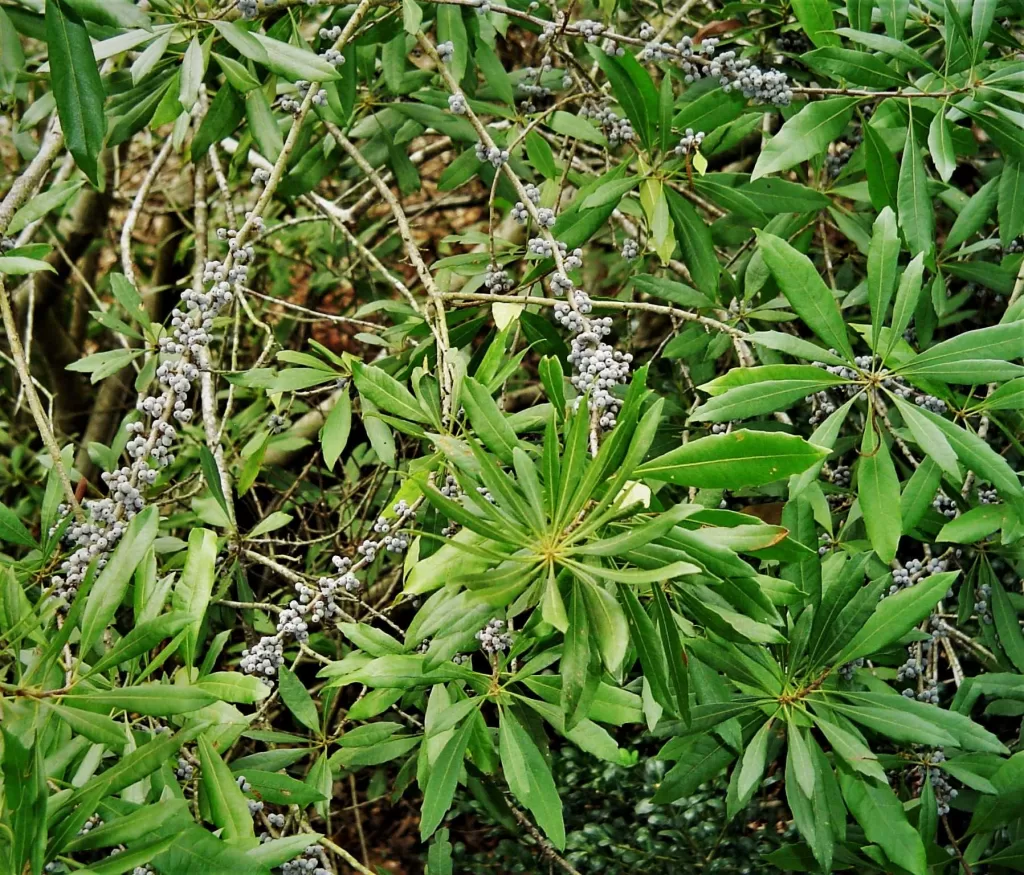
Myrica berries were useful to Native Americans in Eastern North America for wax and medicinal purposes. Identify M. cerifera by the serrated, spiky edges near the tips of its narrow leaves.
Fragrant Bayberry
Bayberry scented wax was rendered by boiling the tiny, waxy drupes which ripen in late summer on Myrica shrubs. Native Americans taught the European colonists how to use these tiny fruits, and the wax was used for making candles and sealing wax in Colonial America. Native Americans also used the berries of some species medicinally, and leaves of one species for flavoring soups and stews.
There are three Myrica species native to the East Coast of North America, and a fourth found on the West Coast. The three species, combined, range from Newfoundland in Canada all the way down the coast, and westwards along the Gulf Coast to Texas. One species also grows in the islands of the Caribbean. All three species produce the fragrant, waxy drupes and all provide excellent cover and forage for wildlife. All three native East Coast species grow in coastal Virginia.
The Myricaceae Family of Shrubs
Myrica is the largest of three genera in the Myricaceae family of plants, which is in the beech, or Fagales, order. There are over 50 Myrica species worldwide. Commonly known as wax myrtle or bayberry, these shrubs are closely related to Comptonia peregrina, the only species within that genus. Known as ‘sweet fern’ for its fern-like leaf structure, this North American native shrub only grows in Zones 2-6 and so is unknown in our area, though it has much in common with our native bayberry shrubs.

M. cerifera, limbed up, grows on the left in the shade garden at the Williamsburg Botanical Garden and Freedom Park Arboretum. An heirloom Viburnum blooms on the right. A native holly grows in front of the Myrica. Spring, 2020.
Humble and Wild
Gardeners wanting the newest, splashiest, most colorful shrubs for their yard will hardly notice Myrica. As with many native plants in their natural form, it is humble and unobtrusive. You might even call it rangy and wild, persistent, and enthusiastic. Most will sucker and form thickets over time, which makes them such a valuable asset for wildlife gardeners. Birds and other small animals find shelter in their dense canopies during heavy weather, secure nesting sites in the spring, as well as a ready food source through the winter. The fragrant oil in their leaves makes them distasteful to grazing animals like deer and rabbits.
While two of the three species remain relatively low, growing only to 6’-8’ tall, southern wax myrtle, M. cerifera, the species most common in our area, will grow into a small tree topping out at 25’ tall and 10’ wide. When limbed up to expose its turning, twisting trunks, it develops great character while providing shelter beneath for a bench and a quiet shade garden. It can be pruned to achieve the charm of our Southern Live Oaks, Quercus virginiana, on a much smaller scale.
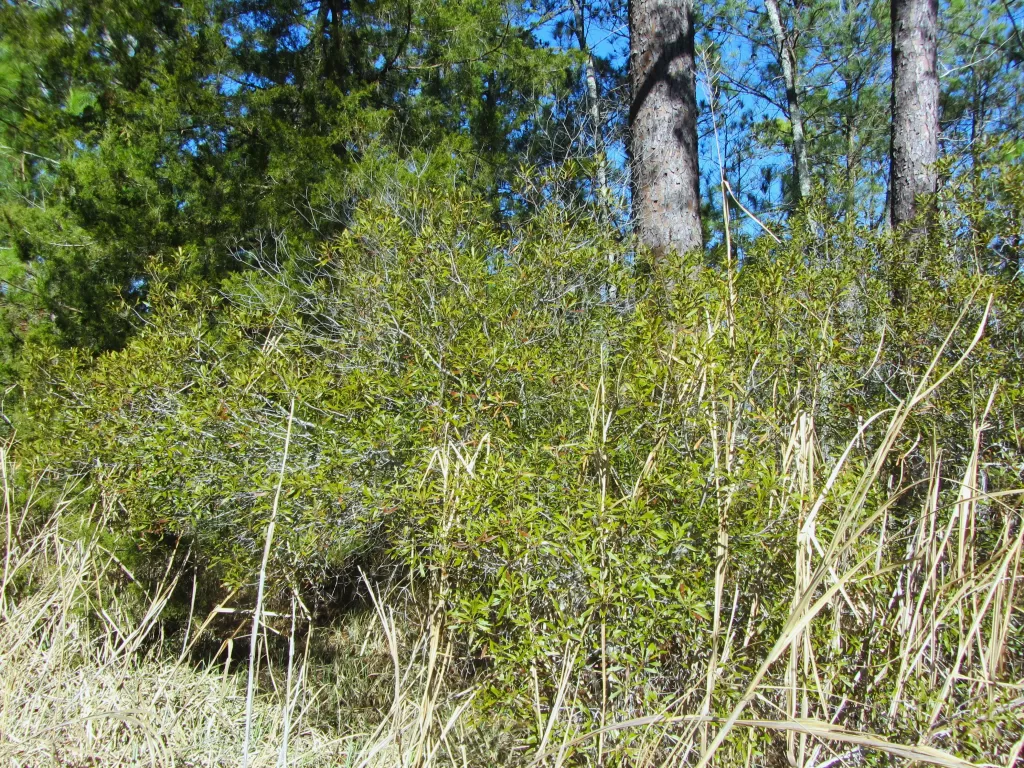
M. pensylvanica grows on Jamestown Island along the loop road beside native pines and red cedar. This stand grows near one of the waterways through the island. Notice it is still heavy with berries in February, 2024.
Tough and Adaptable
All three species will tolerate full sun, partial sun, or even dappled shade. Two will thrive in part shade. All three are salt tolerant and can thrive in polluted air, including near traffic and in urban areas. All three can handle wet soils, as would be found near a river, creek, or pond. But all are also drought tolerant during dry spells. They will grow on a variety of soil types, including sand.
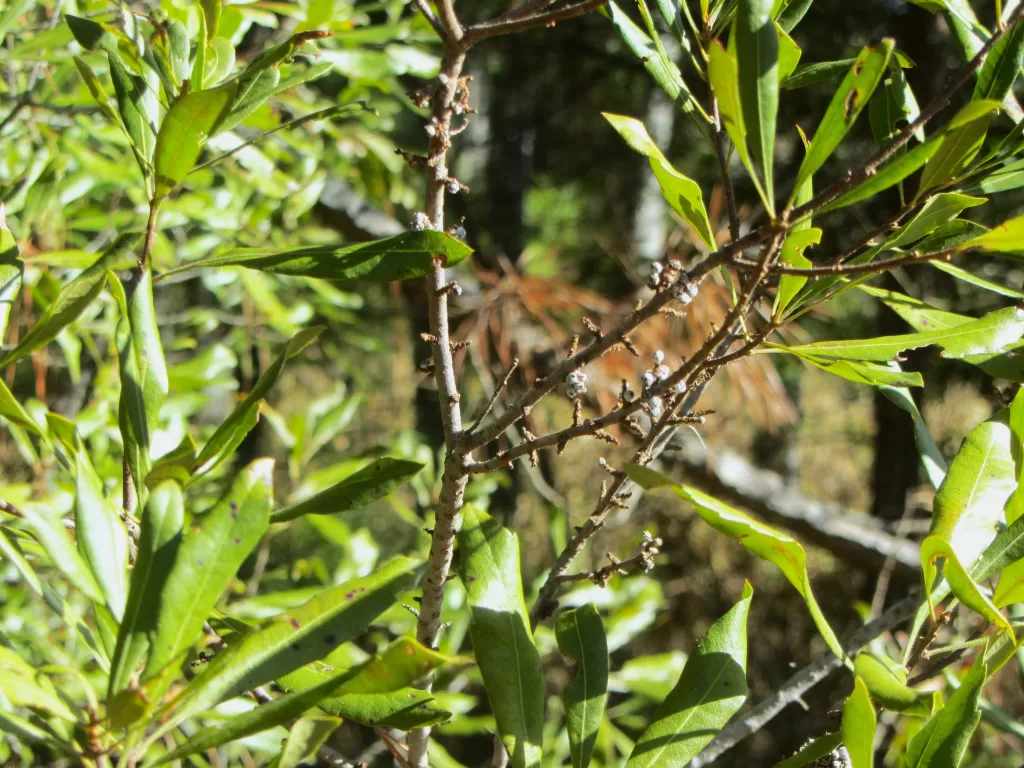
Identify M. pensylvanica, northern bayberry, by its narrow leaves with smooth, but twisting edges. This species only grows near the coast this far south in its native range. February 2024
Myrica’s Superpowers Make It a Superhero of the Garden
All three Myrica species in our area have the superpower of removing nitrogen from the air and then sequestering it in nodules on their roots, in cooperation with bacteria in the soil, to enrich the soil for nearby plants growing as much as 25’ away. Building nutrition in the soil this way also allows Myrica to grow in pure sand on dunes along the coast and on barrier islands. Sometimes Myrica and grasses are the only plants holding dunes and shorelines in such a salty and harsh environment.
Since all are evergreen or semi-evergreen in our climate, they also continue to photosynthesize through the winter months, removing excess carbon dioxide from the air as they breathe and grow. This is an important consideration as we each find ways to contribute to mitigating the highest ever measured carbon dioxide levels in our atmosphere, world-wide. Myrica scrubs the air clean as it produces oxygen throughout the year.
These shrubs are excellent at absorbing excess water after a heavy rain and releasing it back into the atmosphere through their many small leaves. They are an excellent choice for a rain garden or low area in your yard, or along a ditch. Their prodigious root systems hold soil against erosion and so are excellent choices to plant on sloping banks in yards and in drainage fields. These shrubs also offer visual screening along property borders to provide both shade and privacy.
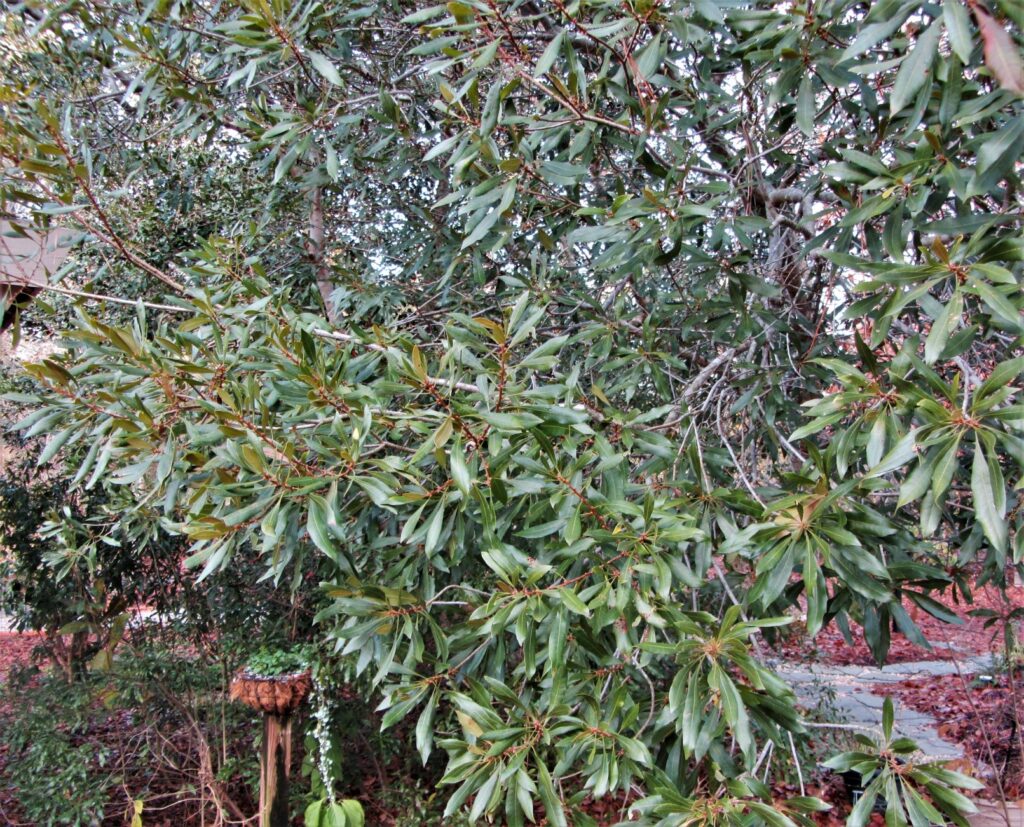
M. cerifera, southern wax myrtle, forms a dense canopy over the shade garden at the Williamsburg Botanical Garden and Freedom Park Arboretum. It requires regular pruning and thinning to control its enthusiastic growth. Autumn 2022
Wildlife Value
Take care to plant these shrubs away from your home or garage, however, because the same essential oils that make them fragrant and help deter deer also make them very flammable. Plant them away from areas of open flame like fire pits and barbecues, but save any prunings to use as kindling.
Insignificant flowers on all three species still support pollinators in the spring, and some are fragrant. Plants are dioecious in most species, so at least one male is needed in each cluster of berry producing female shrubs. Each is also a larval host plant for lepidoptera species and feeds and shelters many other insects as well. While not considered a keystone species in our area, these shrubs have high wildlife value and are highly functional plants in our ecosystem. You will find them growing on the edges of things- along the banks of waterways and roadways, and in the sunny margins on the edges of woods, where they grow wild from seeds dropped by the birds.
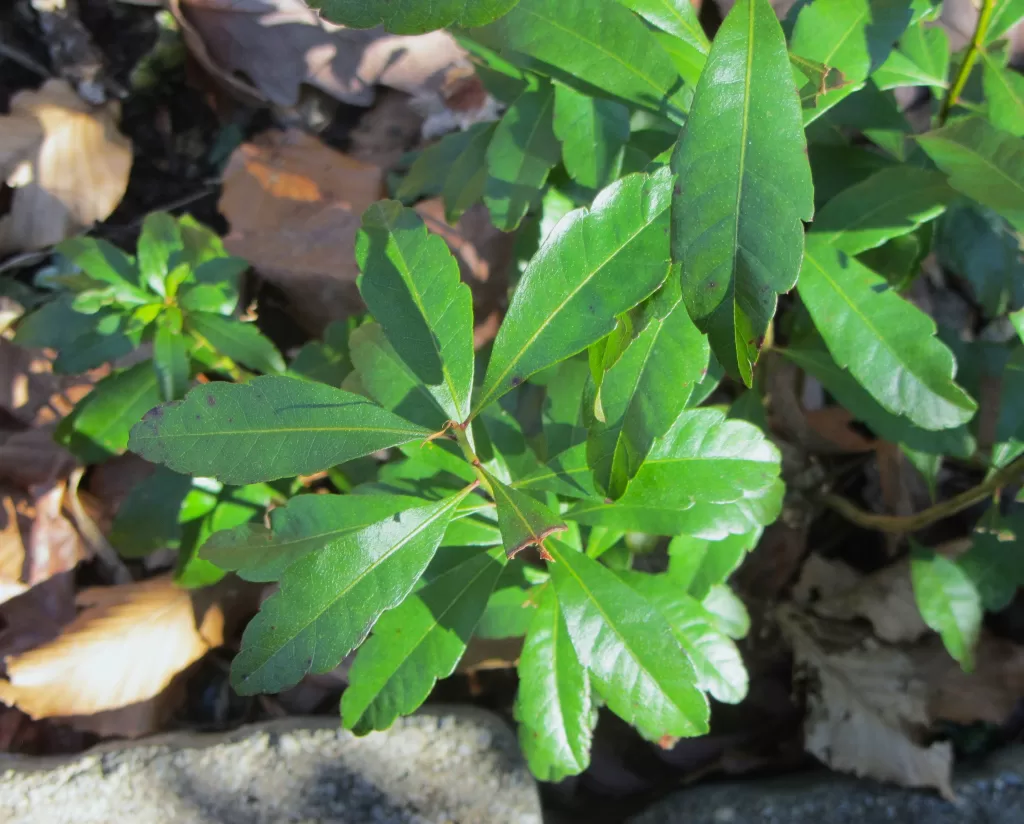
M. caroliniensis, grows as a volunteer seedling in a perennial and bulb bed in my garden. Identify this species with the rounded, scalloped edges on its slightly wider leaf. February 2024
A Weed or Not a Weed?
One of my favorite questions to ask a fellow gardener: “What is a weed?” Their answer tells you a great deal about their understanding of a garden’s ecosystem and their approach to making a garden. The pat answer: “Any plant growing where I don’t want it” demonstrates the prejudice, that most of us share to some degree, that our human sensibility should be the arbiter of what lives and what is killed in a given space. So often, our choices hinge on aesthetics rather than on function. We want something ‘pretty,’ or ‘acceptable to the neighbors,’ instead of considering why a plant has grown into a space, and what function it serves in its relationships with the surrounding ecosystem of animals and native plants in the area.

A seedling southern wax myrtle takes hold in the shadow of a dead pine tree on the bank of a wetland on Jamestown Island. February 2024
Myrica is one of those important native plants in our local ecosystem which may crop up unexpectedly, ‘like a weed’ and may be ‘weeded out’ in favor of something ‘prettier,’ and better known, from the nursery. If you find a Myrica seedling sprouting in your yard, as I do so often, I urge you to grab a shovel and transplant it to an area where it can grow into the fullness of its beauty and its function. Or, pot it and give it to a gardener who does have a space for it.
I have only ever purchased and planted one Myrica from a local nursery to fill an unexpected ‘hole’ after a tree came down in a storm. There are cultivars available with pleasing traits. See Michael Dirr’s Encyclopedia of Trees and Shrubs, listed below, for recommended cultivars, including dwarf forms. It took a few years to establish, and needed irrigation for the first year or two, but the large Myrica I purchased is thriving now.
The Myrica that volunteered from seed in the midst of a bulb and perennial bed got a brutal chop back last summer. It didn’t emerge where I could easily dig it out. And it is still thriving and coming back stronger than before. If you spot a seedling that you want to move, do it while it is very young before its extensive roots develop.

Southern wax myrtle can add tremendous character to a shady garden space, particularly when it has been limbed up to expose its twisting trunks. The WBG-FPA’s shade garden in April 2020, shortly after the Master Gardener Pruning Team worked on the wax myrtle trees to the left.
Plant Myrica With Confidence
All three of the Myrica species described below have important differences from one another, but all share more similarities than they have differences. You will have to look closely at the size and color of their leaves and drupes to distinguish them from one another.
The most economically valuable species, used most often to produce bayberry scented wax and essential oils, is M. pensylvanica, which grows in the northernmost range in North America. It only grows as far south as the Outer Banks of North Carolina and doesn’t grow inland. Since its range is in Zones 3-7 it will likely disappear from our area entirely as our region’s climate warms. Since the USDA changed our climate zone to 8a in November of 2023, this species may struggle to survive here in years to come.
Zone 7a is the northernmost range for M. cerifera and M. caroliniensis, so these two species are smart choices for gardeners adding Myrica to their gardens. M. cerifera will grow in the Piedmont region while M. caroliniensis is found only near the coast. Both can tolerate heat, drought, storms with high winds and excessive rain, and full sun. Plant these shrubs with confidence that they will survive and thrive in your garden.
Three Myrica Species for Coastal Virginia
Myrica cerifera, Southern Wax Myrtle, Zones 7a-11b To 25’ tall and 8’-10’ wide
An East Coast native from New Jersey to the Caribbean, it is indigenous to Coastal Virginia and grows on the coastal plain and in the Piedmont.
Leaf: Waxy evergreen or semi-evergreen, it is fragrant, olive green, 3”-6” long and narrow. It is less than 1” wide, with tiny yellow resin glands on the underside.
Flowers: Small, fragrant, not showy, dioecious flowers bloom in April. Male flowers are catkins, female flowers lack petals.
Fruits: Small, waxy, blue-gray fruits can be rendered into wax and have medicinal uses. They occur only on female plants or sometimes on plants that produce both male and female flowers.
Roots: Dense, fibrous roots hold soil against erosion and fix nitrogen into the soil to feed nearby plantings.
High wildlife value: Dense branches and evergreen leaves provide shelter, flowers provide nectar for pollinating insects and mature into edible berries in late summer. It is a larval host for the Red-Banded Hairstreak butterfly.
Culture: Full sun, part shade, or dappled shade
Swampy soil, sand, poor soil or dry soil
Salt tolerant, wind tolerant, pollution tolerant
Suckers and forms colonies, so allow space to spread
All parts are highly flammable so plant away from a home or garage
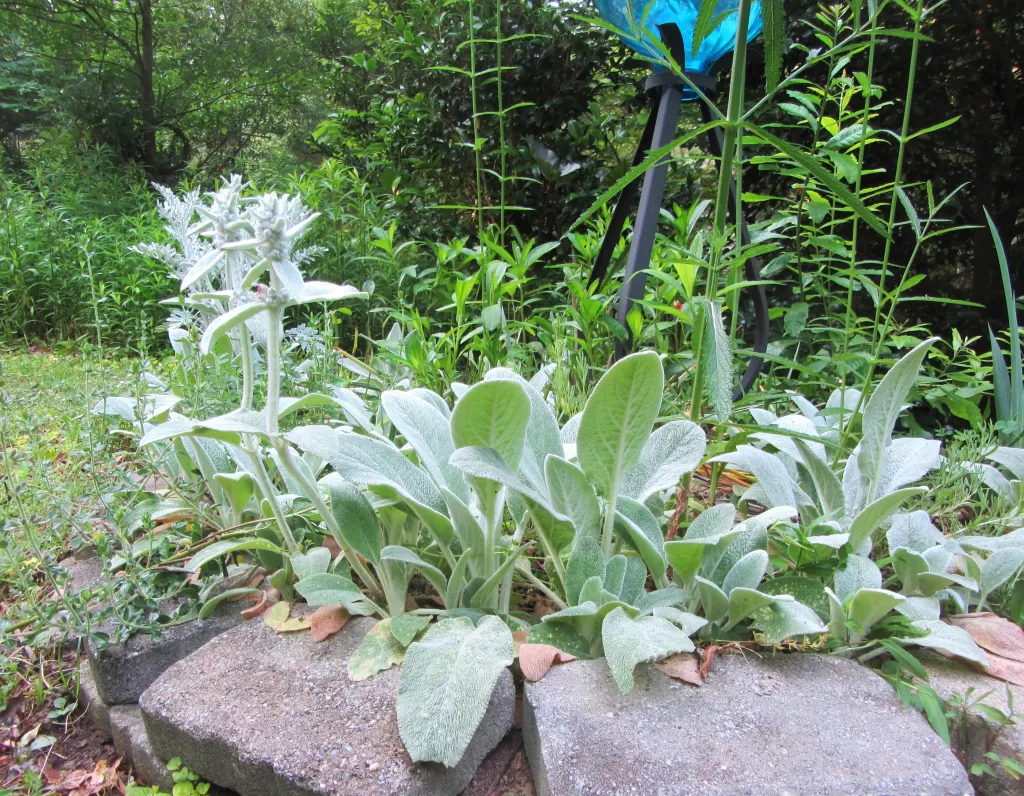
Swamp bayberry grows as a volunteer in the back right edge of this perennial and bulb bed. It wasn’t even visible in April, but grew to several feet high by June of 2023 before I chopped it back. If allowed to grow without careful pruning, it can easily overwhelm this bed in just a few years.
Myrica caroliniensis, (formerly M. heterophylla) Swamp Bayberry Zones, 7a-9b To 8’ tall and 5’-9’ wide
East Coast native from Pennsylvania to Eastern Texas, indigenous to Coastal Virginia, grows on the Coastal plain of the Southeastern US
Leaf: Waxy evergreen or semi-evergreen, fragrant, dark green, 1”-3” long and less than 1” wide, with scalloped margins and tiny yellow resin glands on the underside. Not as fragrant as M. cerifera. Leaves are edible and may be used like bay leaves for flavoring soups and stews.
Flowers: Both male and female are small, cylindrical, yellow to green and appear in late spring to early summer.
Fruits: Small, waxy, blue, gray, silver or white fruits can be rendered into wax and have medicinal uses. They occur only on female plants or sometimes on plants that produce both male and female flowers. Fruits ripen from late summer through early fall.
Roots: Dense, fibrous roots hold soil against erosion and fix nitrogen into the soil to feed nearby plantings.
High wildlife value: Dense branches and evergreen leaves provide shelter, flowers provide nectar for pollinating insects, and mature into edible berries in late summer. It is a larval host for the Red-Banded Hairstreak butterfly.
Culture: Full sun, part shade, or dappled shade
Swampy soil, sand, poor soil or dry soil
Salt tolerant, wind tolerant, pollution tolerant, it suckers and forms colonies so allow space for it to spread. This species may also be pruned into a small tree.
All parts highly are flammable so plant away from a home or garage
Myrica pensylvanica, Northern Bayberry, Zones 3-7 To 8’ tall and 5’-10’ wide
An East Coast native from Newfoundland to North Carolina, indigenous to Coastal Virginia, grows on the coastal plain, often on sand dunes bordering wooded areas.
Leaf: Waxy semi-evergreen, grayish-green to dark green fragrant leaf is 3”-6” long and 1”-3” wide, with tiny yellow resin glands on the underside. Edges are fairly smooth, but may be wavy.
Flowers: Both male and female flowers (on separate plants) are yellow-green catkins, fragrant, not showy, blooming in May. At least one male plant is needed for pollination in each group of berry producing females.
Fruits: Small, waxy, blue-gray fruits can be rendered into wax and have medicinal uses. They occur only on female plants or sometimes on plants that produce both male and female flowers. Fruits appear in late summer and persist until the following April.
High wildlife value: Dense branches and evergreen leaves provide shelter, flowers provide nectar for pollinating insects, and mature into edible berries in late summer. It is a larval host for the Columbia silkmoth.
Culture: Full sun or dappled shade
Swampy soil, sand, peat, or acidic soil.
It is drought tolerant, salt tolerant, wind tolerant, and pollution tolerant. It suckers and forms colonies in good growing conditions and can be limbed up into a small tree.
All parts highly flammable, so plant away from a home or garage
All photos by E. L. McCoy
For More Information:
Dirr, Michael A. Dirr’s Encyclopedia of Trees and Shrubs. Timber Press. 2011.
Mellichamp, Larry and Will Stuart. Native Plants of the Southeast. Timber Press. 2014.
Roth, Sally. Bird-by-Bird Gardening: The Ultimate Guide to Bringing in Your Favorite Birds–Year after Year. Rodale Books. 2009.
Virginia Botanical Associates. 2024. Digital Atlas of the Virginia Flora (http://www.vaplantatlas.org). c/o Virginia Botanical Associates, Blacksburg, VA.
Wasowski, Sally and Andy Wasowski. Gardening with Native Plants of the South. Taylor Publishing Company. 1994.


